The plot of total vapour pressure as a function of mole fraction of the component of an ideal solution formed by mixing liquids X and Y is
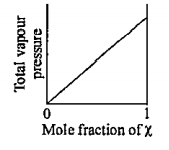
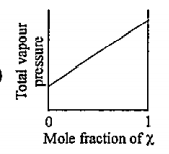
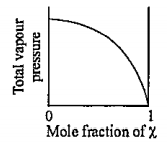
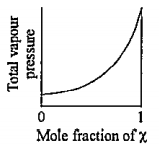
Step by step video & image solution for The plot of total vapour pressure as a function of mole fraction of the component of an ideal solution formed by mixing liquids X and Y is by Chemistry experts to help you in doubts & scoring excellent marks in Class 12 exams.
Topper's Solved these Questions
Similar Questions
Vapor pressure of a solution of Volatile components and composition of vapor: Consider a solution containing 738g of water and 253g of ethanol (C2H5OH) at 323K. At this temperature, the vapour pressure of pure ethanol is 0.292atm and the vapor pressure of pure water is 0.122atm. Calculate the vapour pressure of the solution and mole fraction of every component in vapour phase.
Strategy: First calculate the moles and the mole fraction of each component in the liquid solution. Then apply Raoult's law to each of the two volatile components to calculate their partial pressures. The total vapour pressure is the sum of the partial vapour pressures of the components and the mole fraction of a components in a gaseous mixture equals the ratio of its partial pressure to the total pressure.View SolutionTwo liquids A and B form an ideal solution at temperature T. When the total vapour pressure above the solution is 400 torr, the mole fraction of A in the vapour phase is 0.40 and in the liquid phase 0.75. What are the vapour pressure of pure A and pure B at temperature T?
View Solution
Knowledge Check
- Question 1 - Select One
The plot of partial vapour vapour pressure of solvent verses its mole fraction in the solution of a constant temp.is
Aa straight lineBa straight line parallel to one axisCa straight line passing through originDnone of the above - Question 2 - Select One
When a liquid is completely miscible with another liquid, a homogeneous solution consisting of a single phase is formed. If such a solution is placed in a closed evacuated vessel, the total pressure exerted by the vapour, after the system attained equilibrium will be equal to the sum of partial pressures of the constituents. A solution is said to be ideal if its constituents follow Raoult's law under all conditions of concentrations, i.e., where pi is the partial pressures of the constituent i, whose mole fraction in the solution is xi and p∘i is the corresponding vapour pressure of the pure constituent. The change in the thermodynamic functions when an ideal solution is formed by mixing pure components is given by the following expression.
Δmix=G=ntotalRT∑ixiInxi ...(i)
where, ntotal is the total amount of all the constituents present in the solution.
ΔmixF=−ntotalR∑ixiInxi ......(ii)
ΔmixH=−ntotalRT∑ixiInxi−ntotalR∑ixiInxi=0 ........(iii)
ΔmixU=0 .........(iv)
Since botli the components of an ideal binary system follow Raoult's law of the entire range of the compositions, the partial pressure exerted by the vapours of these constituents over the solution will be given by
pA=xAp∘A ..........(v)
pB=xBp∘B .........(vi)
where, xA and xB are the mole fractions of the two constituents in the liquid phase and p∘A and p∘B are the respective vapour pressure of the pure constituents. The total pressure (p) over the solution will be the sum of the partial pressure. The composition of the vapour phase (yA) can be determined with the help of Dalton's law of partial pressures.
Two liquids A and B form an ideal solution at temperature T. when the total vapour pressure above the solution is 600 torr, the mole fraction of A in the vapour phase is 0.35 and in the liquid phase 0.70. The vapour pressure of pure B and A are:A800 torr, 1300 torrB1300 torr, 300 torrC300 torr, 1300 torrD300 torr, 800 torr - Question 3 - Select One
When a liquid is completely miscible with another liquid, a homogeneous solution consisting of a single phase is formed. If such a solution is placed in a closed evacuated vessel, the total pressure exerted by the vapour, after the system attained equilibrium will be equal to the sum of partial pressures of the constituents. A solution is said to be ideal if its constituents follow Raoult's law under all conditions of concentrations, i.e., where pi is the partial pressures of the constituent i, whose mole fraction in the solution is xi and p∘i is the corresponding vapour pressure of the pure constituent. The change in the thermodynamic functions when an ideal solution is formed by mixing pure components is given by the following expression.
Δmix=G=ntotalRT∑ixiInxi ...(i)
where, ntotal is the total amount of all the constituents present in the solution.
ΔmixF=−ntotalR∑ixiInxi ......(ii)
ΔmixH=−ntotalRT∑ixiInxi−ntotalR∑ixiInxi=0 ........(iii)
ΔmixU=0 .........(iv)
Since botli the components of an ideal binary system follow Raoult's law of the entire range of the compositions, the partial pressure exerted by the vapours of these constituents over the solution will be given by
pA=xAp∘A ..........(v)
pB=xBp∘B .........(vi)
where, xA and xB are the mole fractions of the two constituents in the liquid phase and p∘A and p∘B are the respective vapour pressure of the pure constituents. The total pressure (p) over the solution will be the sum of the partial pressure. The composition of the vapour phase (yA) can be determined with the help of Dalton's law of partial pressures.
For an ideal solution in which p∘A>p∘B, the plot of total pressure (p) us the mole fraction of A at constant temperature in the vapour phase is:A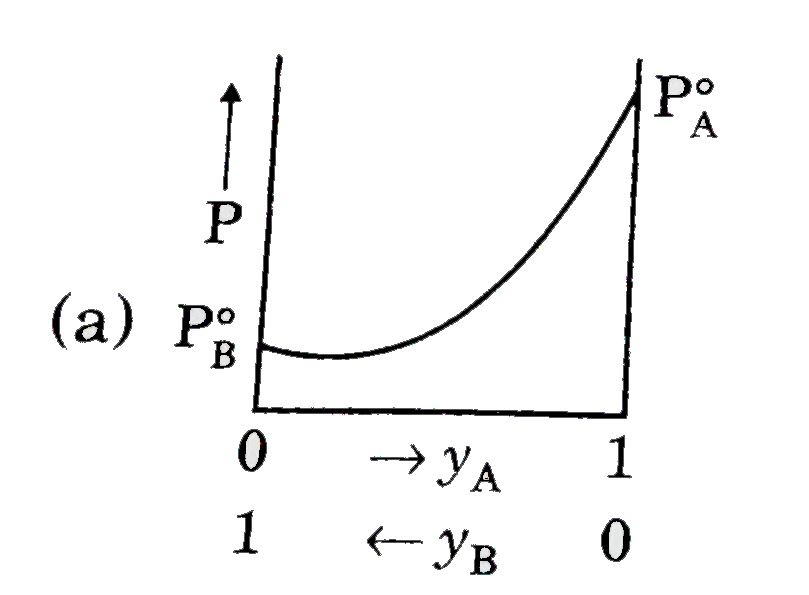 B
B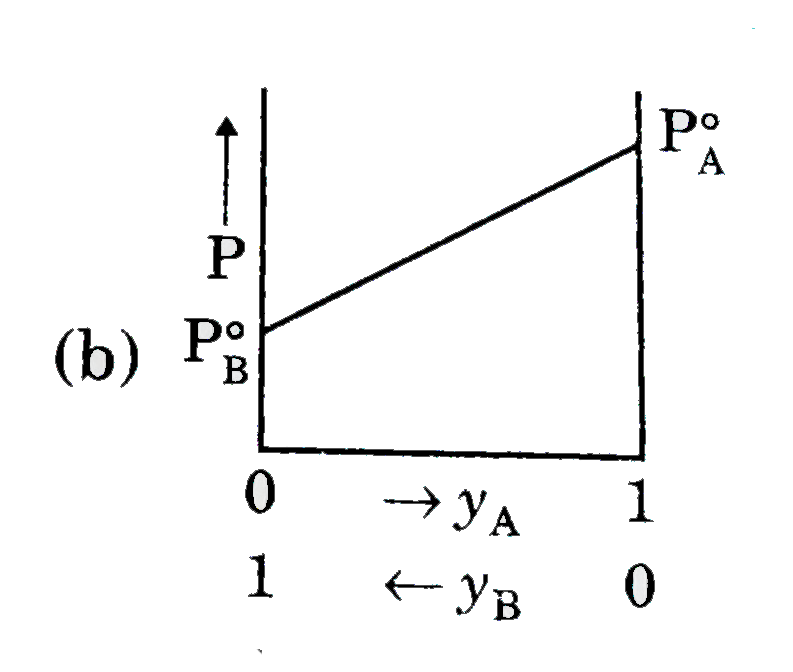 C
C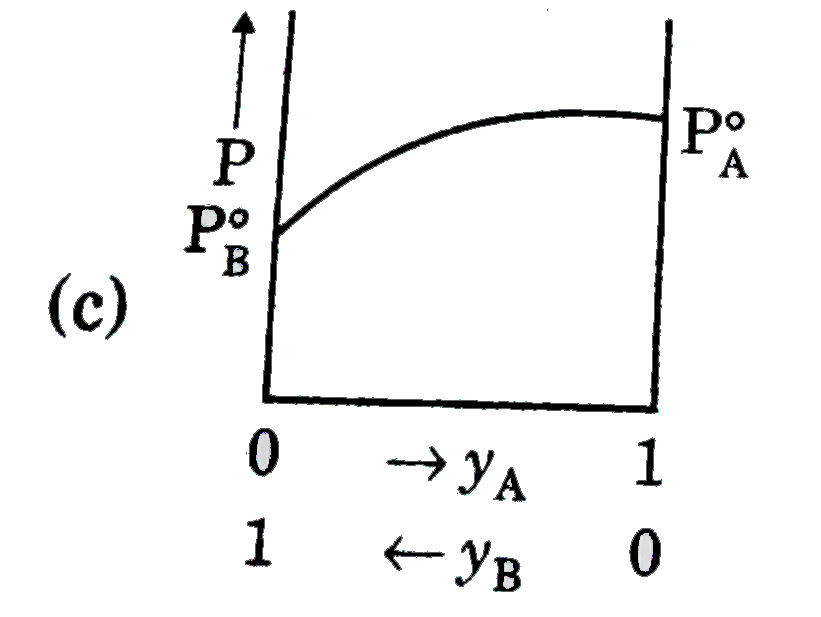 D
D
Two liquid A and B form an ideal solution at temperature T. When the total vapour pressure above the solution is 400 torr , the mole fraction of A in the vapour phase is 0.40 and in the liquid phase 0.75. What are the vapour pressure of pure A and pure B at temperature T ?
View SolutionThe vapour pressure of pure benzene and toluene at 40∘C are 184.0 torr and 59.0 torr, respectively. Calculate the partial presure of benzene and toluene, the total vapour pressure of the solution and the mole fraction of benzene in the vapour above the solution that has 0.40 mole fraction of benzene. Assume that the solution is ideal.
View SolutionWhen a liquid is completely miscible with another liquid, a homogeneous solution consisting of a single phase is formed. If such a solution is placed in a closed evacuated vessel, the total pressure exerted by the vapour, after the system attained equilibrium will be equal to the sum of partial pressures of the constituents. A solution is said to be ideal if its constituents follow Raoult's law under all conditions of concentrations, i.e., where pi is the partial pressures of the constituent i, whose mole fraction in the solution is xi and p∘i is the corresponding vapour pressure of the pure constituent. The change in the thermodynamic functions when an ideal solution is formed by mixing pure components is given by the following expression.
Δmix=G=ntotalRT∑ixiInxi ...(i)
where, ntotal is the total amount of all the constituents present in the solution.
ΔmixF=−ntotalR∑ixiInxi ......(ii)
ΔmixH=−ntotalRT∑ixiInxi−ntotalR∑ixiInxi=0 ........(iii)
ΔmixU=0 .........(iv)
Since botli the components of an ideal binary system follow Raoult's law of the entire range of the compositions, the partial pressure exerted by the vapours of these constituents over the solution will be given by
pA=xAp∘A ..........(v)
pB=xBp∘B .........(vi)
where, xA and xB are the mole fractions of the two constituents in the liquid phase and p∘A and p∘B are the respective vapour pressure of the pure constituents. The total pressure (p) over the solution will be the sum of the partial pressure. The composition of the vapour phase (yA) can be determined with the help of Dalton's law of partial pressures.
A plot of reciprocal of total pressure (1p) (y-axis) us yA (x-axis) gives :View SolutionP→tal=x1p∘1+x2p∘2
=p_1^@ + (p_2^@ - p_1^@) x_2'
I. Total vapour pressure of the solution is related to the mole fraction of any one component.
II. Total vapour pressure of the solution varies exponentially with the mole fraction of component 2.
III. Depending on the vapour pressure of pure components 1 and 2, total vapour pressure over the solution decreases or increases with the increase of the mole fraction of component 1.
select the correct staements derived from the equation.View SolutionThe vapoure pressure of ethanol are 44.5 mm and 88.7 mm Hg respectively at the same temmperature An ideal solution is formed by mixing 60g of ethanol and 40 gm of methanol. The mole fraction of methanol in the vapoure phases is.
View Solution

